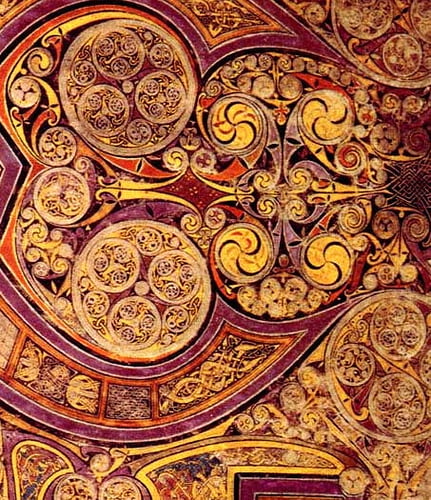I have always been stimulated by the different ‘maps’ of the spiritual journey that have been employed by patristic writers and especially by Bernard of Clairvaux in his sermons and other exhortative writings. For example, in On Loving God, Bernard outlines four degrees of love: we love ourselves for our own sake, we love God for our own benefit, we love God for God’s sake, and we love ourselves for the sake of God. In The Steps of Humility and Pride, Bernard speaks of three degrees in the perception of truth. He writes: “We must look for truth in ourselves; in our neighbor; in itself” (p.34). These ‘maps’ of the spiritual path are a literary tool or literary approach used to image a spiritual framework that immediately draws our attention and stirs up the yearning of our hearts. We can sense that they come out of a rich body of experience and thus can be sure guides for us as we journey through the different seasons of our lives. They are like a compass when we are stuck or lost, in confusion or despair. They keep us oriented towards an ‘end goal’ (teleios: fullness of life, the reign of God) as Cassian will describe it in his Conferences, even while our hearts are taken up by the immediate goal (scopos), which is purity of heart.
Ancient writers often used another literary form called chiasms. We find many chiasms in both the Hebrew Bible and the New Testament. The gospel of John has many easy to find chiasms, the bread of life discourse being one. Oral literature readily used chiasms: they were thought to be used to aid memorization as well as for the aesthetic, poetic dimension of what was being communicated. A chiasm is a style of writing or speaking that uses a repetitive pattern for emphasis and clarification. Its structure or pattern is ‘A-B-C…C’-B’-A’. We can readily understand the importance of repetition in a predominantly oral culture. However, for us today, the repetition of an idea in our fast pace culture, a culture of noise and wordy-ness, is I think an interesting way to get the attention of our hearts and souls. Such repetition, succinct and poetic, lingers around our inner life…we can easily recall again the word-image and feel the depth meaning of how the words are put together: ‘listen, with the ear of your heart’: so the Rule of St. Benedict begins with its chiasm.
This lengthy introduction is leading up to what I learned from Sr. Aquinata Bockmann, in her latest book, A Listening Community. She tells us that the whole ‘Prologue’ to the Rule of St. Benedict is organized in a chiastic structure around a central core, and the central core is verses 21-22. She says that verse 21 “can be represented as a small chiasm” (p.39). Verse 21 reads: “Therefore having girt our loins with faith and the practice of good works, Let us go forward on his ways under the guidance of the Gospel so that we may be made worthy to see him who called us in the tent of his kingdom.” To give you a taste of this literary form here is Bockmann’s analysis of verse 21: “The beginning of girding our loins (A) is contrasted at the end with the goal of seeing (A). Faith (B) is born from listening and is connected with the call and being called (B), and the good works (C) are connected with being worthy (C)” (p.40). She says that this shows that (D) ‘under the guide of the Gospel go forward on his ways’ is the core of this verse and the entire Prologue” (p.40). The structure of this small chiasm is A-B-C-D (D being the core)-C-B-A.
Now to really confuse us all (!), Bockmann in her conclusion to her study of the Prologue writes that “because of the many repetitions” of ideas one could also view the arrangement of the Prologue as a ‘spiral’ (p.76). I found this idea important for us to hear and take in as we read the ‘Prologue’ as lectio. Why? First, what is a spiral? A spiral emerges from a core center; it completes and then begins anew, always building from where it began! In the end we can image a beautiful pattern emerging, not unlike a shell (for example, a shell of a snail!). We all have had the drudgery of experiencing old patterns that we long to be free from repeating themselves over and over. A spiral is different, it completes and yet brings with it a new movement, “spiral with ever new beginnings” (p.76), the result is we are different…the pattern returns but there is something different and new…we are moving, changing, unfolding.
So how is the Prologue a spiral? Sr. Aquinata notes that in the Prologue: “Seven spirals succeed each other. They mirror how our spiritual life develops, yet not in a straight line but rather in the form of a spiral” (p.77). So the chiastic structure of the Prologue has spun seven spirals. Bockmann summarizes the seven spirals in the following breakdown of themes in the ‘Prologue’: “Each spiral contains some characteristic elements, yet still differs from the others. In our life we probably discover something similar: repeatedly there are new beginnings, made possible by God’s call or his grace, by his anticipating us (column 1). If we listen to it all, arise and prepare ourselves (column 2), then we need to confront evil, fight it, and convert ourselves (column 3) and continue to practice good deeds, to obey and run vigorously (column 4). Yet when we do all this, we will again and again realize that we will not be able to reach salvation by our own efforts, however great. Grace comes to our help, it is God who completes. He speaks his ‘here I am’…he acts in us (column 5), and thus enables us to inherit his kingdom (also column 5)” (p.77). These five elements that Bockmann summarizes form a spiral and there are SEVEN of them in the ‘Prologue’, each a little different, each using a new image or repeating an image but used a little differently. It is my hope that all of this will give us a fresh heart and mind as we read and re-read this important piece of the Rule for it is the spiritual foundation and backdrop of the entire document.
Now one last important point that Bockmann ends with: she points out that each spiral or circle is different. What she means is that: “At one time the anticipating action of God is dominant or our listening or the battle against evil; at another time it is the purposeful running or acting, or our depending on God who is acting and dwelling in us” (p.77). The Prologue offers a hopeful and realistic picture of the monastic journey. It is not a linear journey: this journey with God moves in spirals where if we are ready and committed with our ‘yes’ all things will be possible…God in Jesus is present always, to anticipate our every need…grace awaits on the threshold of whatever we are dealing with and our lives are creating spirals of Divine life and love.
A Voice in the Wilderness
He appeared, he was preaching and attracting crowds in want of inner freedom. He came as prophet of the Most High. Who is this one? The last of the prophet,


